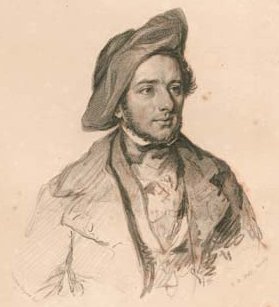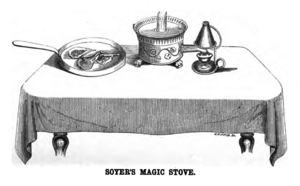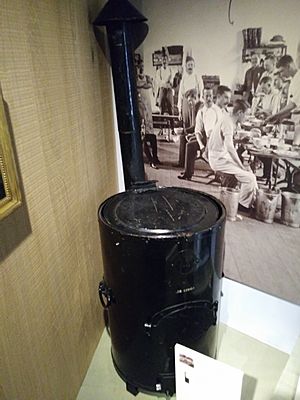Alexis Soyer facts for kids
Alexis Benoît Soyer (born February 4, 1810 – died August 5, 1858) was a famous French chef. He became one of the most celebrated cooks in Victorian England. Soyer was also known for helping people in need.
He tried to help the poor during the Great Irish Famine (1845–1849). He even gave money from his book sales to help. Later, he worked to make sure British soldiers had better food during the Crimean War. He invented a special cooking stove, called the "Soyer stove." This stove was used by the British army for many years, even until 1982!
Contents
Biography
Early Life and Training
Alexis Benoît Soyer was born in Meaux-en-Brie, France. His parents were Emery Roche Soyer and Marie Chamberlan. The family moved to Meaux in 1799. They were attracted by the town's reputation as a place for Huguenots, who were French Protestants.
Alexis's father had several jobs, including being a grocer. Not much is known about Soyer's very early life. His secretary, François Volant, said that Soyer's parents wanted him to become a Christian minister. They sent him to a Protestant school when he was nine.
However, Soyer did not like this path. He complained to his parents and managed to get himself dismissed from the school. This happened around 1820. A year later, in 1821, he moved to Paris. He lived with his older brother, Philippe.
Becoming a Chef
In Paris, Alexis began his cooking career. He became an apprentice at Georg Rignon's restaurant. This restaurant was located near the Passage des Panoramas. Later, the Rignon restaurant moved to the Boulevard des Italiens.
In 1826, Soyer moved to Maison Douix. This was a very large restaurant. Within a year, he became a chief cook there. He led a team of twelve other cooks. By 1830, Soyer was a second cook for Jules, Prince de Polignac. Polignac was the French prime minister at the time.
Moving to England
On July 26, 1830, a revolution happened in France. It was called "Les Trois Glorieuses" (The Three Glorious Days). During this time, armed people broke into Polignac's kitchens. Two staff members were shot. Soyer managed to escape. He then fled to England.
In England, Soyer joined the household of Prince Adolphus, Duke of Cambridge. His brother Philippe was already the head chef there. After this, Soyer worked for several other important British people. In 1832, he became a sous-chef (second chef) for Henry Beresford, 3rd Marquess of Waterford.
He soon moved to work for George Leveson-Gower, 2nd Marquess of Stafford. He also worked for Elizabeth Sutherland, 19th Countess of Sutherland. They became the Duke and Duchess of Sutherland in 1833. The Duke died that same year. His daughter-in-law, Harriet, became an important friend and supporter of Soyer throughout his life.
Soyer worked for the Leveson-Gower family for a short time. He then took charge of the kitchens for William and Louisa Lloyd. They owned three large properties in Shropshire. Soyer worked for the Lloyds for over three years. He became well-known among the wealthy families in Shropshire.
Marriage and the Reform Club
While working for the Lloyds, Soyer met Elizabeth Emma Jones. She was a painter. He married her in 1837. Soyer then left the Lloyds. He became head chef at the Reform Club in London. He worked there from 1837 to 1850. He also helped design the club's new and modern kitchens.
His wife, Emma Jones, became a very popular painter. She mostly painted portraits. She was one of the youngest artists to show her work at the Royal Academy of Arts. She exhibited a painting there in 1823 when she was only 10 years old. Emma died in 1842 after problems from a difficult childbirth. Soyer was very sad. He built a monument for her at Kensal Green Cemetery in London.
Alexis Soyer died on August 5, 1858. At the time, he was designing a mobile cooking carriage for the British Army. He was buried next to his wife in Kensal Green Cemetery on August 11.
Innovations and Help for Others
Modern Kitchens
In 1837, Soyer became the head chef at the Reform Club in London. He worked with Charles Barry to design the kitchens for the new club building. Soyer earned a very high salary, over £1,000 a year. He brought in many new ideas. These included cooking with gas, using cold water to cool refrigerators, and ovens with temperatures that could be adjusted.
His kitchens became so famous that people took tours to see them. When Queen Victoria was crowned in 1838, Soyer prepared a breakfast for 2,000 people at the club. Some of his dishes, like "Soyer's Lamb Cutlets Reform," are still on the club's menu today. Soyer was also good at promoting himself. He sold "Soyer's Sultana's Sauce" in a special bottle with his picture on it.
Helping During the Famine
During the Great Irish Famine in April 1847, Soyer invented a type of soup kitchen. The government asked him to go to Ireland to set up his idea. He opened a soup kitchen in Dublin. His "famine soup" was given to thousands of poor people for free. The government chose his soup because the ingredients were cheap.
While in Ireland, Soyer wrote a book called Soyer's Charitable Cookery. He gave all the money from the book sales to different charities. He also opened an art gallery in London. He donated the money from entrance fees to charity to help feed the poor.
The Magic Stove and Other Ventures
In 1849, Soyer started selling his "magic stove." This stove allowed people to cook food almost anywhere. It was designed to be a small, portable stove that could sit on a table.
Soyer left the Reform Club in May 1850. He designed something for The Great Exhibition, a huge event planned for 1851. His design was not chosen. Instead, Joseph Paxton designed the famous Glass House. Soyer opened his own event called the Gastronomic Symposium of All Nations in 1851. It was located near the Great Exhibition in Hyde Park. Before it opened, he held a big dinner for newspapers from all over Europe. However, Soyer lost a lot of money, about £7,000, and had to close his venture later that year.
Soyer also wrote several cookbooks. His 1854 book, A Shilling Cookery for the People, was a recipe book for everyday people. It focused on simple recipes that didn't need fancy kitchen tools or expensive ingredients.
Improving Army Food
During the Crimean War, Soyer went to join the troops. He paid his own way at first. He wanted to advise the army on how to cook better. Later, he was paid for his expenses and earned as much as a Brigadier-General. He helped organize the food supplies for army hospitals.
He designed his own special field stove, the Soyer Stove. He also trained and placed a "Regimental cook" in every army unit. This was to make sure soldiers got enough good food. It helped prevent them from suffering from poor nutrition or getting sick from bad food. Soyer wrote a book called A Culinary Campaign about his work in the Crimea.
Even though Soyer made big improvements, army food standards were still not always good. It wasn't until 1945 that a special Army Catering Corps was created. Today, their main building is called Soyer's House. Soyer's stove, or similar versions of it, was used by the British military as late as the Gulf War.
Soyer returned to London on May 3, 1857. On March 18, 1858, he gave a lecture about army cooking. He also built a model kitchen at the Wellington Barracks in London.
Works
British Army catering officers still have an annual dinner. They often use Soyer's old recipes for the menu. Here are some of his works:
- Culinary Relaxtion. (1845)
- Délassements Culinaires. (1845)
- The Poor Man's Regenerator (1848)
See also
 In Spanish: Alexis Soyer para niños
In Spanish: Alexis Soyer para niños




